THE BLUSHING BOULE (PURPLE YAM COUNTRY BREAD)
HOW DARE I BARGING IN WITH MY “ORIENTAL” VEGETABLE, LIKE A BRUTE IMBECILE WAVING A BOX OF STUPID CRAYONS, JUST SO I CAN PAINT AN ALREADY-PERFECT LOAF OF ART, PURPLE?
So lately, if you have been paying attention, you’d notice that I’ve been somewhat, disturbingly obsessed with this color here. Hey, I swear, I didn’t know I had it in me either. I mean, com’n, pastel purple? What am I, Hanna Montana? But seriously, starting exactly 7 days ago, I swear it came at me like a never-ending nightmare too dazing and beautiful to wake up from, I kept and kept baking things – FOUR loafs of bread as we speak to be exact – obsessively colored in this gigglish hue which I was never that into even when I was 4. What’s happened to me?
To trace back steps, I must say that it started out innocently enough, as it happens to all of us, by an epidemical mental illness called PGSD – Piggish Grocery Shopping Disorder. I have been haunted by this persistent disease, which I have no doubt that I’ve gotten from my mother, for much longer than this ever-expanding body of mine can endure. On my weekly shopping routine, online as I should also point out, any promotion too friendly or a banner too distracting, can trigger a behavioural mechanism that causes me to literally… rob their entire inventory of “Buying In Bulk”. Ask my house keeper – who comes carefree to clean our apartment, but often leaves burdened with forced souvenirs of over-ripen bananas – and she’d tell you that I need help.
However, it’s one thing to let my disorder roam free as long as it’s within the premise of A) Preservative-laiden, edible mummies that last forever like 6 stacks of Pringles, or B) Guilt-tripped purchases on healthy fruits and vegetables like a dozen avocados or 4 Hawaiian pineapples (did I mention there are only TWO of us). But it’s something else entirely when it spills over into the category of perishable, filling, and ass-expanding starchy root-vegetables like… 5 whole pounds of Vietnamese purple yams.
But you guessed it. That was exactly what happened. My PGSD had led me into an unending supply of baked purple yams that, before long, I knew I had to put those purple yams somewhere else faster than they could start sprouting and turn my apartment into Molly’s backyard.
But at first, it wasn’t this. The first bread that digested my over-supply of baked purple yam, was a gorgeous and delicious purple yam-pullman loaf. I mean it was a no-brainer, replacing the sweet potato in my sweet potato rolls with purple yam, for purple slices of sweet and moist toasts that were perfect on their own to be eaten straight-up (which in fact we did)(which in fact was declared by Jason, the sweet bread-hater, to be the first pullman he’s ever liked). Simple logic. But the success of that pullman had emboldened my imagination, to push the implementation of baked purple yam, along with the beautiful color and flavours it brings, into the more sophisticated and less-messed-with territory of bread making. Armed with my recent fascination on this book, I decided to embargo on a purple yam-bread, artisanal style.
I mean, how dare I? The making of artisan-style breads (or some say, European style) – in today’s baking world where people are stuffing mocha custards into abominations called cruffins, or puttin ground beef on donuts – is a sanctuary of purity, highly regarded by its elegance of simple ingredients transformed only through the refinement of crafts. Even the title of the book speaks hostility at any intrusions – flour, water, salt, yeast, period. So how dare I barging in with my “oriental” root-vegetables, like a brute imbecile waving a box of stupid crayons, just so I can paint an already-perfect loaf of art with the colour purple? Meaningless gimmick? OH but it wasn’t.
To your skepticism, the baked purple yam brought more than colour here. Like the use of tang-zhong/flour-roux in the making of Japanese milk toasts, the cooked starch from the purple yam increases the flour’s ability, as well as duration, to retain what is utterly important in all good breads: moisture. There’s nothing sadder than watching the bread you spent almost 24 hours on, turning helplessly into something only as good as croutons after just one good meal. But this looker here, aside from the beautiful blushes of lilac-purple and the faint and almost floral fragrance in the back-note, had the moistest crumbs and nearly translucent tissues that were soft and chewy at the same time, but most importantly, even after being sliced open, remained that way into the better part of the second day. Using new techniques I’ve learnt from the book, it was also filled with gloriously large bubbles, and an organic and mesmerisingly gorgeous crackings across the surface. Don’t you love a good ending? I feel like this is a love story of a neurotic PGSD patient, a simple farmer from the Southeast, and a gentle and elegant artisan from France, who had together fallen into a passionate but twisted orgy and ended up making a baby together. And their future, is looking more happily-ever-after than ever.
And that baby, you should make one yourself.
Makes: One 8 1/2″, or 22cm loaf
The length of the instruction has nothing to do with the addition of purple yam. It’s long because I’m including a lot of details of what I had learnt from the book – Flour Water Salt Yeast – which can be applied to all types of “European/Artisanal” bread-making. I tried to include as much as I can, but I would still highly recommend the book if you want a comprehensive but easy-to-understand coverage on this subject.
A note on purple yam. The addition of purple yam (aka ube) is not just a gimmick for color here. Like using dong-zhong/roux in bread-recipes, the baked purple yam gives it moisture as well as the ability to retain it for longer, therefore as a result, this bread dries out much slower than the other loaves I’ve made before. Flavour wise, the purple yam also leaves a faint and floral fragrance in the back-note. I haven’t tried using yellow yams, but perhaps that could result in similar effect… minus the pretty color. If you want to make a purple yam pullman, you can use the sweet potato roll recipe here, and substitute the sweet potato with equal amount of purple yam. Then braid and bake the loaf like this Hokkaido milk bread.
There are a lot of different fermenting/proofing schedules for overnight breads, but right now, I prefer this one the most. It finishes all the fermenting, shaping and proofing on the day before, and the only thing left to do when I wake up the next morning, is to bake it (straight from the fridge!). It fits my life-style, and makes the serving-day completely stress-free.
The overnight bread recipe/techniques are based on the book: Flour, water, Salt Yeast. This bread can be made with exactly the same instructions and ingredients, minus the purple yam, if you want to make a white country loaf.
Ingredients
- 400 grams (3 cups) bread flour, or all-purpose flour
- 312 grams (78% hydration)(312 ml) water, at 86F ~ 95F/30C~ 35C
- 150 grams (37%)(roughly 3/4 cup packed) baked and peeled purple yam
- 9 grams (2.2%)(1 1/2 tsp) fine sea salt
- 1 gram (0.3%)(1/4 tsp) instant dry yeast
Instructions
- This bread will need about 1 hour for mixing/folding, 4~5 hour to ferment at room-temperature, then 12 hours/overnight in the fridge to slow-proof, and another 2 hours to bake and cool down. So please start 19 ~ 20 hours before the time you want to serve the bread.
- According to the book, the optimal temperature for any bread dough - after it is folded/kneaded, and just before it's left to ferment - should be at 78F/26C. So if your indoor temperature is quite cool, around 68F/20C, you should warm the water to about 95F/35C to achieve that. If your indoor temperature is warm, like mine, around 79F/26C, then the water should be about 86F/30C to achieve that. I have an instant thermometer and therefore, I can measure these things accurately. But if you don't, IT IS OK, just start with water that feels like your body temperature, meaning that when you insert you finger into the water, you can't quite make out whether it's on the "cool side" or "warm side". I like to prepare a large bottle of water at the right temperature (more than the recipe calls for), then pour the amount I need as I measure on a scale.
- TO START: In a large bowl, mix flour and water (already warmed up to the optimal temperature) with a fork until just even. Cover with plastic-wrap and let rest for 20~30 min. (This process is called "autolyse", which allows the flour to hydrate, releases enzymes and increases its flexibility... blah blah. Wanna know more, you can Google it). After rested, add the baked and peeled purple yam, and sprinkle the fine sea salt and instant dry yeast evenly across the surface.
- TO KNEAD WITH MACHINE: If you're using a stand-mixer or handheld-mixer with dough-hooks (like I did because we're lazy) knead the dough on medium-low speed for 20 min. The dough should still be very wet and sticky, but quite smooth and very elastic. It should be able to hold its shape for a short period of time, and appears to be stringy when it pulls away from the bowl. If you have an instant thermometer, the dough should be at 78F/26C now. Cover with plastic-wrap, and let ferment for 4~5 hour until almost TRIPLED (not doubled).
- TO FOLD WITH HAND: If you were mixing with hands, finely mash the purple yam before adding to the bowl. Using the pincer method to evenly distribute the ingredients (this blog gives a good step by step photos on pincer method and folding). Then pull the dough up from one side until just before it tears, then fold it over itself towards the opposite side. Turn the bowl around by 45 degrees, and fold again. Do this for about 5 min until the dough starts to develop some elasticity. Let the dough rest for 10 min, then fold again for 30 seconds. If you have an instant thermometer, the dough should be at 78F/26C now. Cover with plastic-wrap and let ferment. In the first 1 hour, every 15 min, come back and fold the dough like you did for 30 seconds. Then leave it for about 3~ 4 hours until almost TRIPLED (not doubled).
- TO SHAPE THE BREAD: Dusting with just enough flours onto the dough/ the counter/ and your hands to prevent sticking as you go, now gently ease the dough out of the bowl, onto the working surface, without flattening or tearing it. The dough should look kind of like a blob on the counter. Again, gently, pull 1 corner of the dough up and fold it over itself. Repeat for 3~4 times around the dough until it comes into a ball. Now flip the dough over so the "seam-side" now faces down, onto a less floured surface. Using the friction between the counter and the dough, cup your hands around the dough and pull it gently towards you. You should feel the dough tightening as you do this. Repeat for 3~4 times from all directions until the dough comes into a good, round shape.
- TO PROOF THE DOUGH: If you have a proofing-basket, dust it with flour and gently transfer the dough, seam-side down, into the basket. If not, using the original bowl that the dough fermented in, and line it with 1 sheet of parchment paper. Press the parchment so it conforms to the shape of the bowl, then dust the dough all around with a little flour, and transfer into the bowl, seam-side down. Cover with plastic-wrap, then proof in the fridge for 12 hours/overnight.
- TO BAKE THE BREAD: 45 min before baking, preheat the oven on 475F/245C, with a lidded Dutch oven on the rack. Once the oven's preheated, take the dough out of the fridge (no need for it to warm back to room-temperature). Lift the dough out of the bowl by lifting the parchment paper, then gently place on the counter. Put another piece of parchment paper on the side, then gently flip the dough onto the seconds parchment. Without flattening or tearing it, dust the edges with a little flour to gently release the dough from the first parchment. Now the seam-side should be facing up.
- (NOTE: Why not just use the first parchment to transfer the dough, from the bowl, directly into the Dutch oven? I've done it both ways, and noticed that the dough which was inverted after proofing, had a much better rise in the oven. During proofing, most large air bubbles gathered at the upper-half of the dough, leaving the lower-half slightly denser. If not inverted, the baked dough inherently came out with a denser lower-half, and less tall. But by inverting, the low-half was now at the top, which allowed it to expand more during baking, and the larger air bubbles at the bottom, helped push the dough upward as well. And the seam-side also creates a beautiful cracking on the surface.)
- Take the preheated Dutch oven out and remove the lid. Lift the parchment to transfer the dough into the Dutch oven (leave the parchment with it as well)(flatten the parchment's folds so it doesn't distort the shape of the bread). Close the lid and bake for 25 min. Then remove the lid and bake for another 13~15 min, until the surface is deeply browned. Remove the parchment and let the bread cool on a cooling-rack for 1 hour.
Notes
To cook the purple yam, bake in a preheated 400F/200C oven for 45 min ~1 hour until a knife can be easily inserted into the flesh. Cool completely before using.
The percentages provided in the recipe is the baker's percentage, defined by weight (ex: the weight of water should be 78% of the total weight of flour). I have never measured this recipe by volume, or most bread recipes for that matter, and I don't think you should either. Measuring bread recipes by weight provides accuracy, and most importantly, allows you to alter the quantity easily with percentages. So please try to do that.



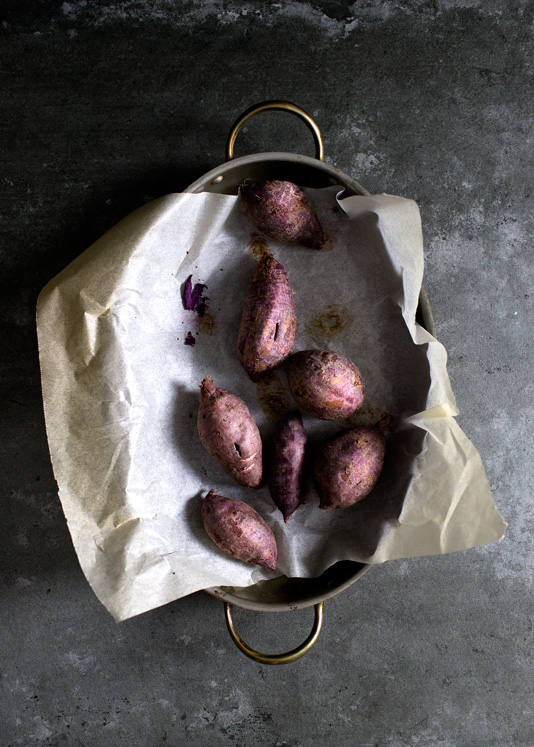
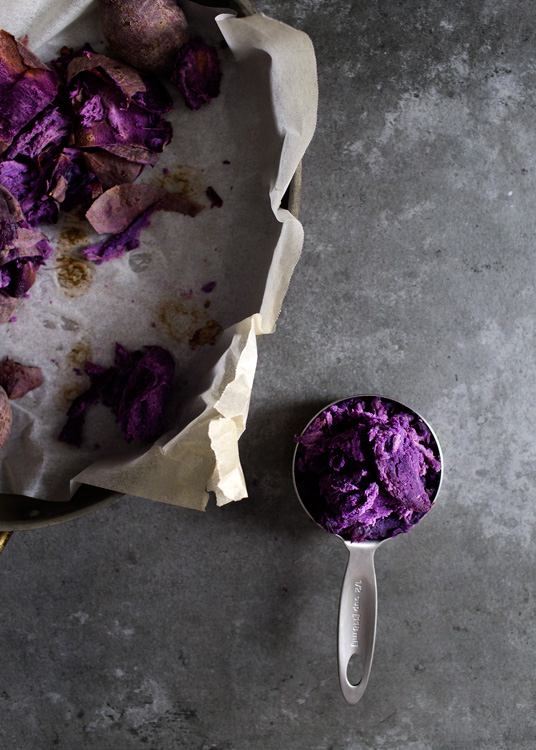
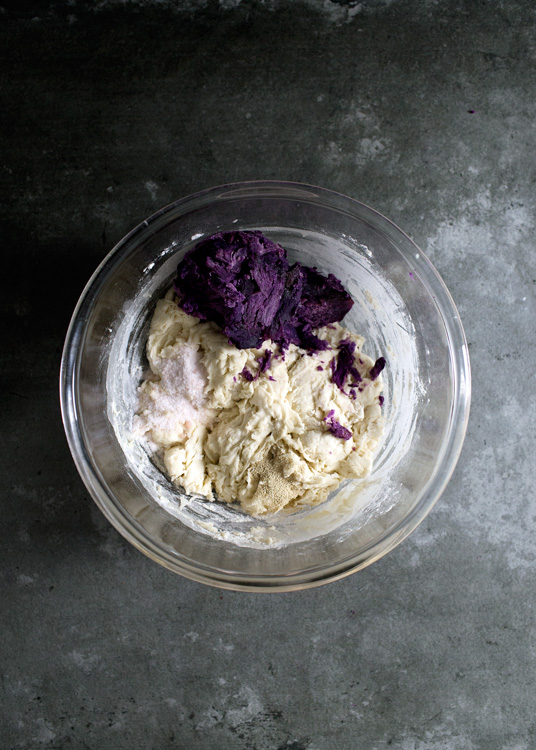
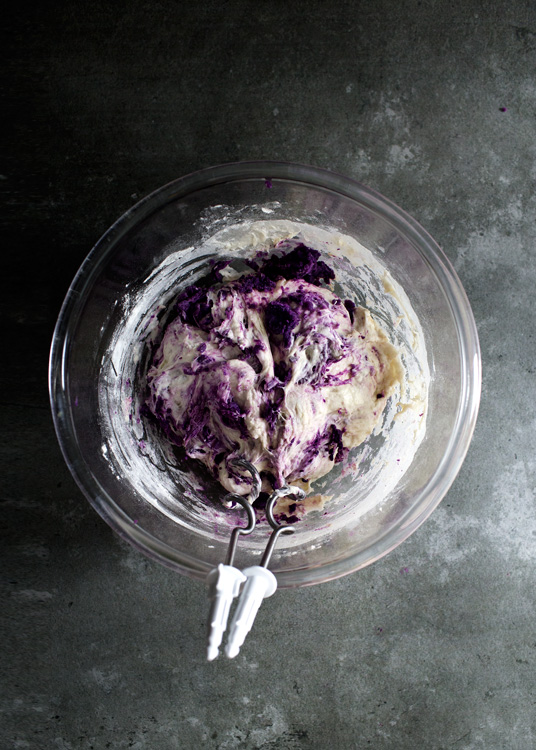



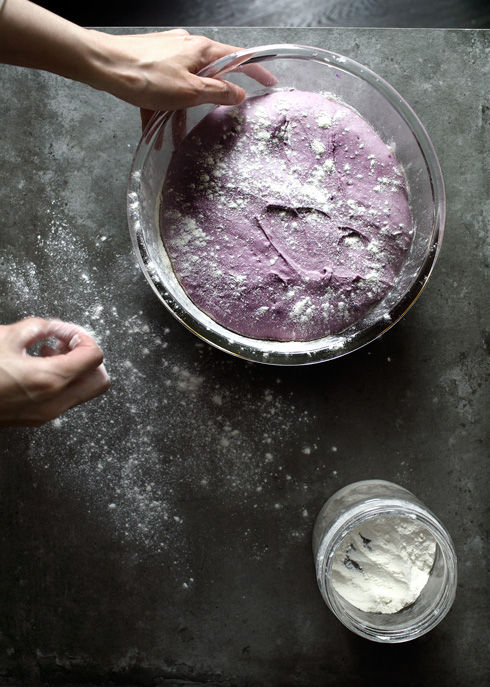


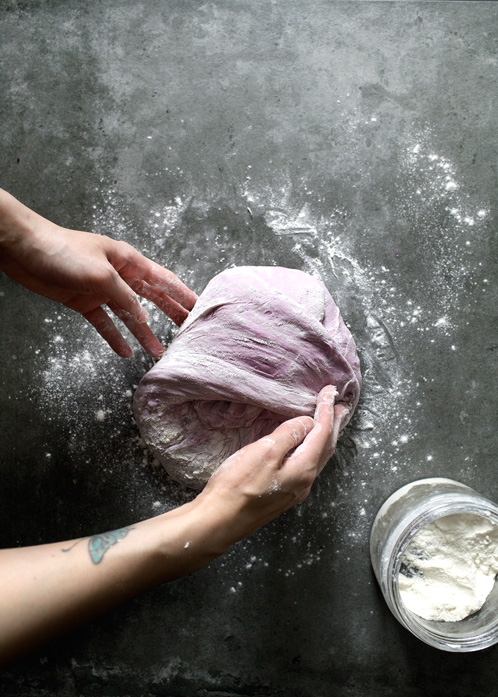



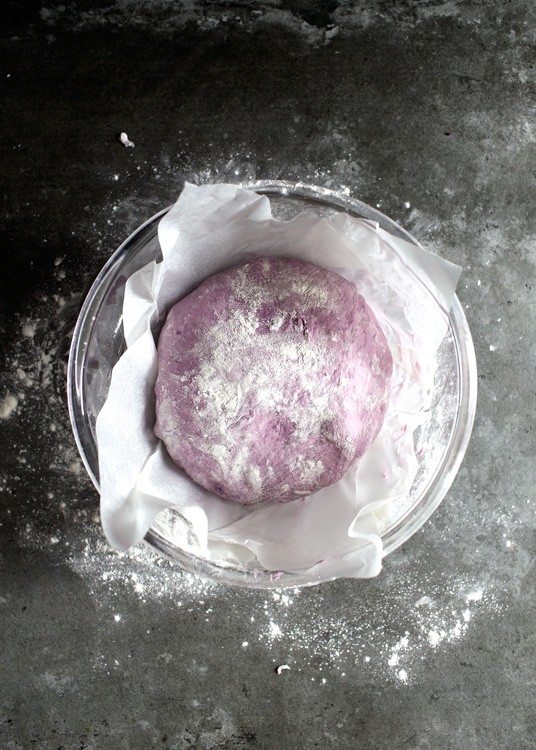
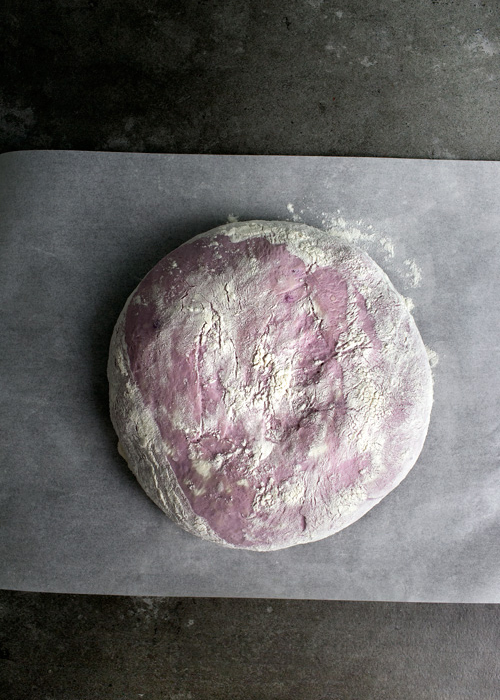
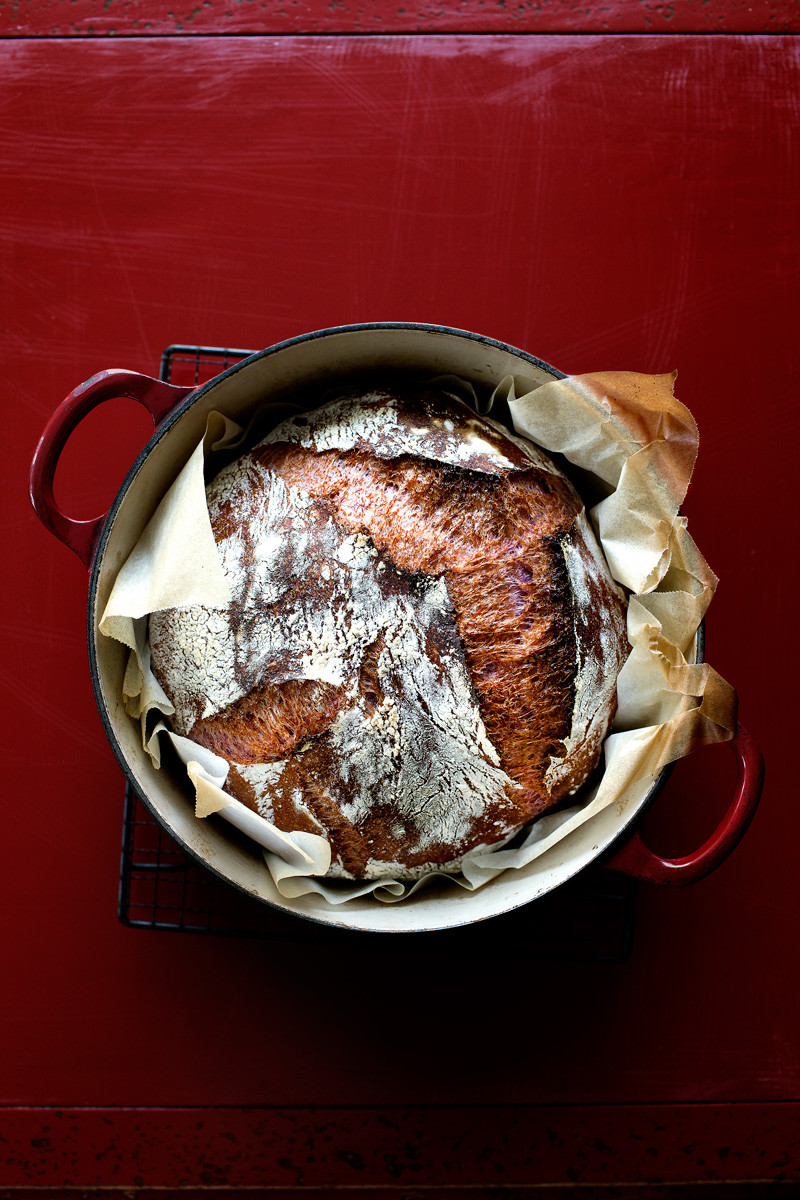


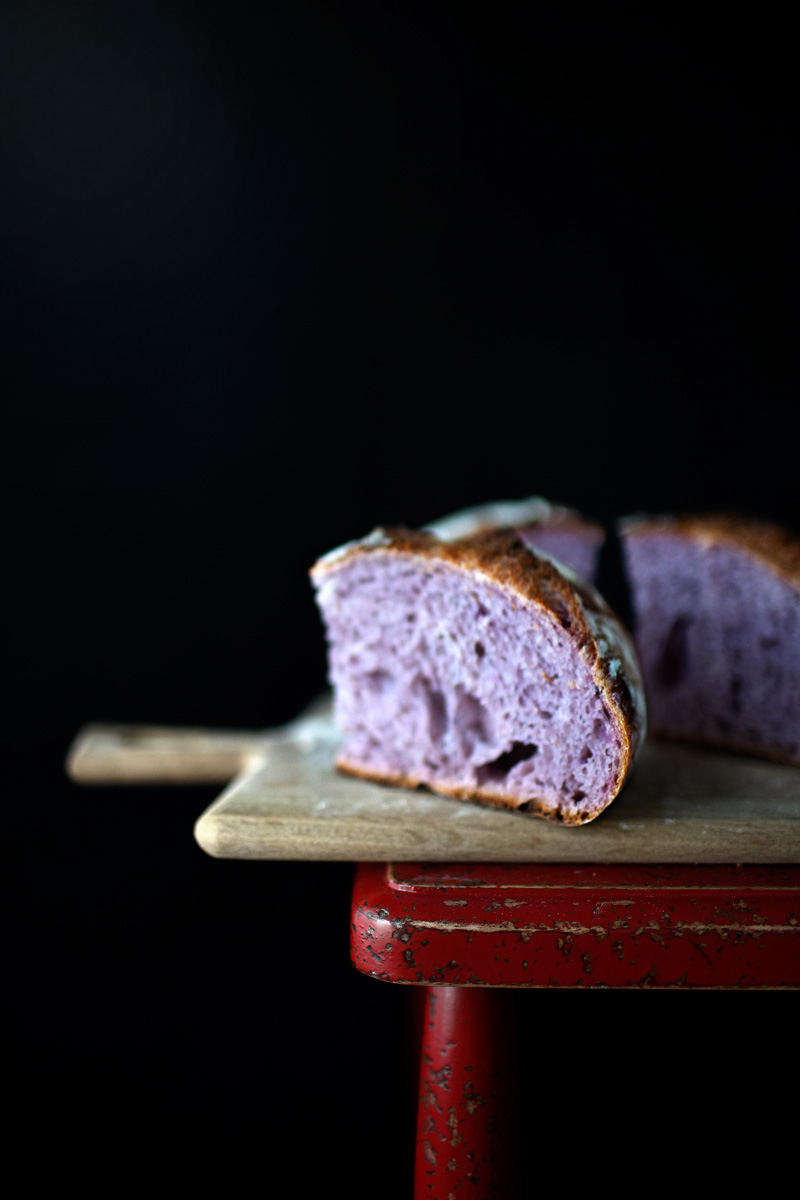
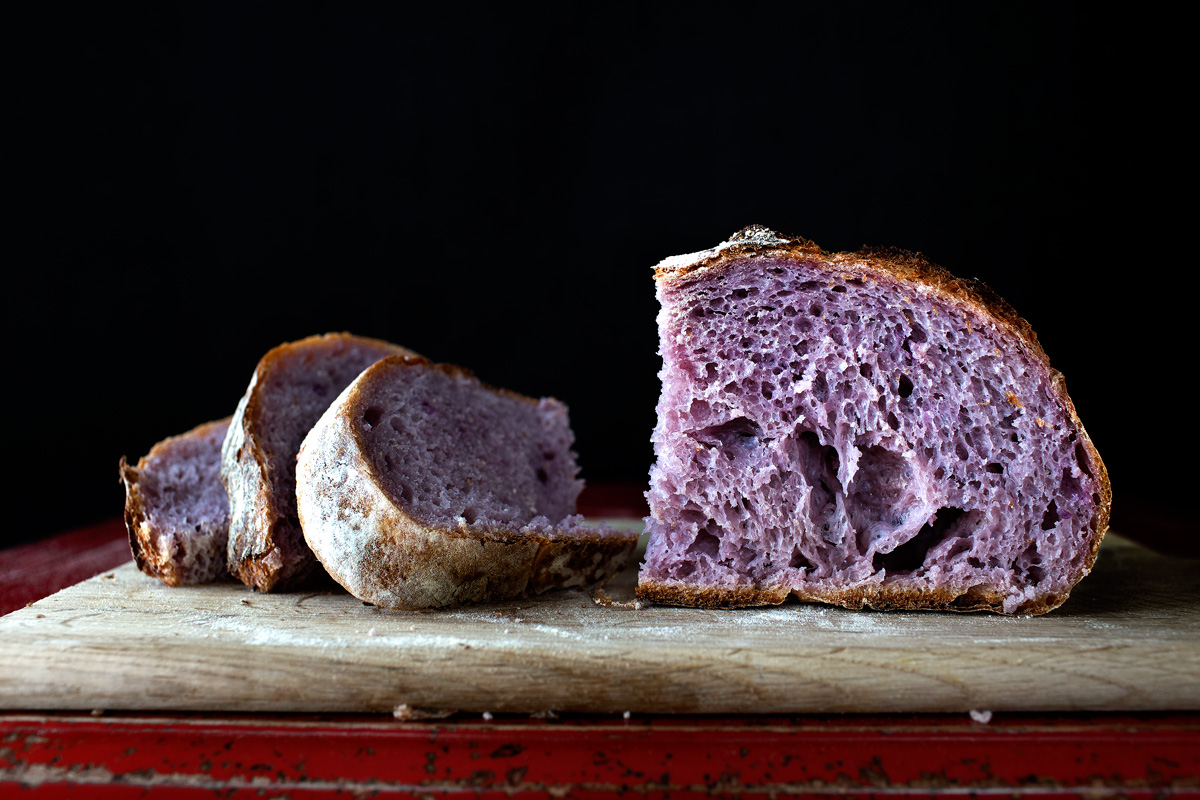

emily
04.27.2015at8:01 PMThat is just insanely gorgeous! I love the color purple yam/ube/taro gives to things.
aimee @twigg studios
04.27.2015at8:16 PMWow what a beautiful colour. I don’t think I have ever seen purple yams here in the UK but I will definitely look out for them now. Your photos are amazing.
Belinda @themoonblushbaker
04.27.2015at8:27 PMPurple bread (or any coloured bread) is the in thing! Your bread is blooming magnificent!
Dini @ Giramuk's Kitchen
04.27.2015at8:27 PMI know one other person who is obsessed with this colour! Sadly she won’t bake this beautiful boule unless I bake it for her, but I WILL share this with her and taunt her!! I love purple yam but never eaten it in baked products!
This bread looks beautiful! I mean… honestly just amazing! The pictures of the kneading got to me and now I need to go bake some bread…
La Blonde Femme
04.27.2015at9:01 PMawww WOOOWWW!!!
I’m seriously in love with this amazing purple bread!!!!! :D
Ursula @ LilVienna.com
04.27.2015at9:14 PMThis looks soooo cool!
mythy huynh
04.27.2015at9:26 PMI can’t wait to make this. But can I ask, what have you made with this bread? Any sandwiches? I only ask b/c I love your category “Shit I eat when I’m by myself!” =P
mandy@ladyandpups
04.27.2015at9:31 PMMythy, I literally ate this straight up, with a little butter and honey! It was so good I didn’t need anything else. But you can use it to replace any bread that you usually use :)
Melinda
04.27.2015at9:37 PMIt’s good to know I’m not the only one who suffers from PGSD.
Siqi
04.27.2015at10:20 PMWhat if I don’t have a Dutch oven? Can I put it on a baking pan?
mandy@ladyandpups
04.28.2015at12:15 AMHaven’t tried it before. Without the humidity inside a Dutch oven, you may not be able to get a good crust. But you can try placing a hot steam bath on the bottom of the oven, or throwing ice cubes to create steam, as some ppl do. But I don’t know how well that works…
Jackie Fletcher
04.27.2015at10:36 PMyou are really badass awesome. I can’t get purple yam here in the DC area, but I can get purple potato. Let’s wait and see what I will get….
Charlie (Chockywoky)
04.27.2015at10:49 PMat last. a solution for using up those yams in the fridge.
Thanks for sharing Mandy :)
Katrina @ Warm Vanilla Sugar
04.27.2015at11:02 PMThis bread is bonkers (in the best possible way)! Love the colour!
megan
04.27.2015at11:15 PMDREAM LOAF.
molly yeh
04.27.2015at11:58 PMlol i just imagined harvest coming around and realizing that all of the sugar beets were accidentally purple yams. i would have no choice but to make 12,000 loaves of this bread. it is so beautiful and crusty and isn’t bread in a dutch oven the best?!?!
Rebecca @ DisplacedHousewife
04.28.2015at12:26 AMLove bread in the dutch oven. It’s fascinating that the crust seems to resist the purple color??
Thalia @ butter and brioche
04.28.2015at6:34 AMI’ve never made a bread in a dutch oven before so this technique is definitely one I will be trying. I love that you used purple sweet potato too – though it’s hard to find here in Australia… I will need to keep my eyes peeled it looks incredibly delicious and SO pigmented.
Alexandra @ Bright-Eyed Baker
04.29.2015at3:21 AMThis loaf is gorgeous! Love the vibrant color and all the step-by-step photos!
Levy
04.29.2015at6:11 PMQuestion! Are these yams in the American colloquial sense or Asian purple sweet potatoes?
mandy@ladyandpups
04.29.2015at6:16 PMLevy, they are not purple potatoes, but yam/sweet potatoes. I don’t know if there’s a difference between American and Asian though.
tunie
05.02.2015at5:01 AMThey are different from purple potatoes – sweet and denser, like a regular sweet potato, but purple-fleshed. But people make potato bread, so try with whichever you have!
Levy
05.05.2015at4:50 AMUm, I didn’t mention potatoes? *confused*
I’m just checking to see which colloquial is being used as Americans in some regions call sweet potatoes yams (I don’t know why) and 99% have never actually seen or eaten a real yam! reference: http://www.thekitchn.com/whats-the-difference-between-yams-and-sweet-potatoes-word-of-mouth-211176
And I live in Malaysia and looooooovvveee my purple sweet potatoes even though it’s a bit less common than the regular yellow/orange sweet potatoes; yams however, I’m not too enthused about the taste and texture, purple or not.
Yams and sweet potatoes may be tubers but they’re wholly different in taste and texture.
ellie | fit for the soul
04.30.2015at5:15 AMThose process shots….Waahhh! They’re so beautiful and fluffy I just want to tear the raw dough apart. Mmmm! And seriously though. Any asian household needs a bulk of yams especially of the purple variety.
Pork Salami Astoria
04.30.2015at5:10 PMThis is soooo good!
kimithy
05.09.2015at4:36 AMI had an inappropriately audible laugh/snort at work because of “edible mummies”. Thanks for that :)
mandy@ladyandpups
05.09.2015at8:45 PMKimithy, you’re completely welcome :)
Francheska Marie
05.15.2015at10:12 AMI just made this recipe and I believe I messed up the water measurement because the dough was very moist and sticky. Wondering how much water I should use if measuring in cups. Live your blog!
mandy@ladyandpups
05.15.2015at4:59 PMFrancheska, the dough should be very moist and sticky! It’s a highly hydrated dough. It would not be precise to measure by cup, but 312 grams = roughly 1 1/3 cup.
Debb
05.27.2015at3:20 PMHello-
Can’t wait to make this bread, what if I don’t have a Dutch oven? .. Will a cast iron pan work?
Lauren
06.09.2015at12:39 AMI have never made bread before but my mom bought three purple Japanese yams and asked me to do something with them so I made this bread, and it was a huge hit! I didn’t have a dutch oven, so I used an oval casserole dish and put tinfoil on for the lid. Thank you so much for sharing this :)
Netta
12.11.2015at11:39 AMHi, I just made this and I got great reviews; the color is amazing. But as I was working with it (and this is the second time I made the dough), I noticed it was incredibly moist to the point of not being able to retain any shape. It baked relatively flat with a nice structure inside, but I also chose too large a Dutch oven I believe. Any tips? Thanks.
mandy@ladyandpups
12.11.2015at1:44 PMNetta, different yams and root vegetables have different moisture content, so maybe the variety you use contains more moisture. You can decrease the amount of water to compensate :)
SAMANTHA
03.06.2016at1:23 PMJust made the dough today and it is now proofing in the fridge. I also had the same problem where the dough was too moist that it wasn’t holding the shape and it kept sticking to my hand. I used Japanese purple sweet potato and fermented about 4.5 hrs inside the oven with the light on (oven off). Do you think it was hard to manage the dough due to it being too warm? I had to keep folding and dusting with a lot more flour until it started to hold the shape. Do you think the extra folding and more flour will impact the texture?
SAMANTHA
03.07.2016at1:12 PMThe bread turned out beautiful, but I think adding the extra flour and folding during shaping made it more dense. Will definitely try again by reducing the water amount to see if it makes it easier to shape the dough.
mandy@ladyandpups
03.07.2016at7:46 PMSamantha, I’m thinking perhaps your purple yam contained a bit more moisture than mine. Extra folding will develop more gluten and help the dough hold its shape. I would try adding less water and more kneading next time :)
Samantha
03.29.2016at12:46 PMHi. Can you go over the baking method again? I’m not sure when I put it in to bake it at 400…. is it after I put it in 475, I let it cool, and then bake it again at 400?
mandy@ladyandpups
03.29.2016at3:55 PMSamantha, you bake the bread in 475F/245C oven with the lid on for 25 min, then lid off for 15 in :)
Samantha
03.30.2016at9:00 AMThat little amount of time? I put it in for 45 mins at 400. Whoops. No wonder it is so hard. This is my second time doing it and it still didn’t rise. What am I doing wrong?
mandy@ladyandpups
03.30.2016at5:00 PMSamantha, oh boy I have no idea… Did the dough rise during the first proofing (at least doubled)?
Francheska Marie
11.15.2016at5:02 AMI love this bread recipe and keep coming back to it whenever I want to wow guests :) I’ll be baking multiple loaves for Thanksgiving this year and was wondering if I could use something else to bake it in since I only have one dutch oven and the process to prep the dough is so long. I was thinking about using my Le Creuset covered casserole (stoneware). Would this work? Thanks!
mandy@ladyandpups
11.15.2016at12:21 PMFrancheska, I haven’t tried so I can’t say for sure, but I think any heavy, heat-retaining pot with lid should goodb:)
Kristy
01.12.2017at4:07 PMI do not have Dutch Oven, so I’m planning to bake this in a casserole dish? I kind of doubt this would work, but this bread looks so glorious I have to try.
If anyone has used a Corningware Casserole Dish for this kind of baking before, please do enlighten me.
mandy@ladyandpups
01.12.2017at6:09 PMKristy, is your casserole dish heavy and deep? I think as long as it’s thick and deep enough to hold the final size of the bread, and with a heavy lid that traps the steam, it should be okay.
Kristy
01.12.2017at10:56 PMIt’s deep. Not so sure about the thickness of it. Did a little Google searching, which has given both sides of the equation, i.e. “both dish + lid are oven-safe” vs “NO! Mine shattered in the oven!” :/
I might just stick to a metal pot, with a lid or aluminium foil to help seal steam in.
Kristy
01.15.2017at12:42 PMSo.. I made this today.
I had the same problem with others regarding moisture level in sweet potatoes etc, ended up with an incredibly wet dough that stuck to everything on God’s green earth. Including the parchment it was baked on. Should I have used a greaseproof/wax coated baking paper instead? Or was it solely because my dough was wet?